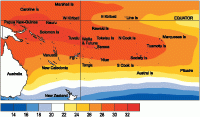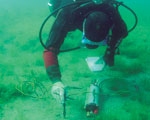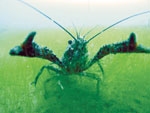PDF of this article (271 KB)




Capable of growing taller than a three-storey building, hornwort is the latest aquatic weed to invade our waterways and lakes. Fleur Matheson, Rohan Wells, and Kay Vopel map its spread through New Zealand.
Hornwort is currently considered New Zealand’s worst submerged weed. The reasons for this include its ability for rapid spread, growth in a wide range of waterbodies, and growth to deeper depths than other weed species. It’s also the tallest-growing weed, recently found to be growing to 10 m in height in Lake Maraetai as a very dense surface-reaching weed bed. Weed beds such as this can be both an aesthetic nuisance and a serious recreational hazard.
Like most other submerged weeds, hornwort does not set seed in New Zealand, but reproduces from broken-off fragments that are easily moved to new sites on boats, boat trailers, fishing gear, float planes, and weed harvesters. Just a small fragment of the plant can generate enough new plants to fill another lake.
From an ecological perspective, hornwort beds outcompete and smother all other aquatic plants. This includes native submerged species as well as other noxious invaders such as the oxygen weeds egeria (Egeria densa) and lagarosiphon (Lagarosiphon major). Overseas, hornwort is often regarded as a weed of more nutrient-enriched waters; however, the spread of this weed into Lake Taupo and Lake Tarawera is evidence that in New Zealand it can also do well in more unsullied lakes, particularly in sheltered bays and at deeper depths.
Hornwort’s non-rooted growth form is unique. Alhough it can anchor itself to bottom sediments with buried stems, taller plants are easily dislodged by strong currents or waves and can form large drifting weed rafts. These are commonly seen, particularly during autumn, in Lake Rotoaira and the Waikato River lakes where the rafts obstruct hydroelectric power station intakes. This results in substantial costs associated with removal and lost generation.
History of hornwort's spread
Hornwort is popular overseas for use in aquariums and ornamental ponds and it was probably introduced into New Zealand for these purposes. The plant was first recorded in natural waters near Napier in 1961. A couple of years later it was recorded at Mihi Bridge on the Waikato River, from which it rapidly dispersed, with masses of the weed causing the closure of the Lake Ohakuri power station in 1965. From these initial sites, hornwort has since spread from Northland to Manawatu, and is currently known to be present in over 30 North Island lakes.
Until recently hornwort had not managed to spread to the South Island, but in 2002 the plant was found in a stream and several ponds near Motueka. Concerns about protecting the many pristine South Island lakes from the ravages of this plant prompted the Department of Conservation and local authorities in the Nelson area to act swiftly to contain it and implement an eradication programme. Evidence from this incursion suggested that the hornwort had probably been planted in an ornamental pond and had escaped to a nearby stream. However, some people hold the misguided belief that this weed can benefit fisheries and wildlife values of waterways, and it may have been unwittingly introduced along with coarse fish.
Ongoing threat
Hornwort poses a serious environmental and economic threat to New Zealand’s lakes and rivers. At particular risk are the South Island’s lakes, including many that are currently untouched by any exotic weed species. Cooler temperatures in the South Island will be no barrier to hornwort: it overwinters under ice in the northern hemisphere and has proved to be particularly troublesome in high-altitude Lake Rotoaira (central North Island), where winter water temperatures can drop to 4 °C.
A growing threat is posed by increased movement of boats and eel fishers between the North and South Islands, which heightens the risk of hornwort spread. Boat users and eel fishers must be extra vigilant about removing weed from their boat and trailer as they leave lakes, particularly if moving their boat to hornwort-free areas. Although hornwort, and other weeds, will eventually dry out and die if kept out of water for long enough, fragments can survive for months in wet spots under the floor or in the anchor well of boats.
Hornwort's vital statistics
| Name | Hornwort or coontail (Ceratophyllum demersum L.) |
|---|---|
| Family | Ceratophyllaceae |
| Origin | Native to North America, probably introduced to NZ via the aquarium trade |
| Key Attributes | Ranked NZ's worst submerged weed |
| NZ's tallest-growing submerged weed (up to 10 m) | |
| NZ's deepest- growing submerged weed (to depths below 12 m) | |
| NZ's only non-rooted submerged weed | |
| Sale and distribution prohibited under the Noxious Plant Act 1979 |
Invasion timeline
| 1961 | 1963 | 1981 | 1982 | 1985 | 1997 | 1999 | 2002 |
|---|---|---|---|---|---|---|---|
| Hawkes Bay | Waikato | Bay of Plenty | Manawatu | Northland | Wanganui | Auckland | South Island |
| Drains, Tukituki River | Mihi Bridge, Waikato River | Lake Rotoiti | Manawatu River | Lake Ngakeketa | Lake Whiritoa | Lake Kereta | Moutere Stream and ponds, Motueka (possibly now eradicated) |
Hornwort in Lake Taupo


Hornwort was first detected in Lake Taupo in 1980. Following the recent discovery of the weed in the South Island, NIWA scientists have been looking at the current distribution, potential for further spread, and ecological impacts of hornwort in Lake Taupo to better understand the threat posed by this plant to large, high-quality lakes.
Not all of the shoreline around Lake Taupo is suitable habitat for aquatic plants, due to steep, unstable slopes or exposure to wind and wave disturbance. However, plants grow well in the shallow, sheltered bays, and recent surveillance has confirmed that hornwort is well established in many of these areas (for example, Waihi Bay, Stump Bay, Acacia Bay). There is considerable potential for further expansion and spread, particularly into areas which still harbour good native plant communities (such as Motuoapa Bay and Two Mile Bay).
While the detrimental effect of hornwort on native plant biodiversity is well known, we know less about the effect of these weed beds on local water quality and native fauna. When we measured water quality at a selection of hornwort, native, and bare sites around Lake Taupo, we found no differences in water column oxygen levels, but found that hydrogen sulphide levels were slightly higher close to the sediment in dense hornwort beds. Further research is required to determine whether the higher sulphide levels could make dense hornwort beds unsuitable habitat for native bottom-dwelling fauna, such as koura (freshwater crayfish).
Dr Fleur Matheson and Rohan Wells work with freshwater biosecurity. Dr Kay Vopel is a benthic ecologist with expertise in biogeochemistry. The authors all work at NIWA in Hamilton.
Author contact: [email protected]
Teachers’ resource for NCEA AS: Biology 90461 (2.5), 90718 (3.6). See other curriculum connections at www.niwa.co.nz/pubs/wa/resources
